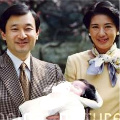Crown Princess Masako: One Big Step More on the Way Towards Recovery
Last Sunday, Crown Princess Masako of Japan, who has suffered stress-induced illness while struggling to adjust to royal life, made her first public appearance outside of Tokyo in about 15 months. The princess attended the 20th national “Midori no Aigo” green conservation event at the Yokohama Animal Forest Park, along with her husband, Crown Prince Naruhito. After an address of the crown prince on the importance of greenery in attempts to tackle global warming, he and the princess both planted cherry trees, in commemoration of the event. After that, the couple visited the park zoo and the Japan Guide Dog Association’s Kanagawa training center to watch guide dog training.
Princess Masako is a diplomat’s daughter who grew up in several different countries and speaks four languages. She gave up a promising career after hesitation to marry Crown Prince Naruhito in 1993 and has expressed wishes to fulfil her role as crown princess by serving as an unofficial ambassador for Japan, a wish that her husband shares. But all the traditionalist Japanese court actually wanted from Masako – who is, by her qualifications, an ideal crown princess in the modern sense – was a male heir for the throne.
Unfortunately, no child was born to the royal couple in the first years of their marriage. In consequence, the couple were put under a sort of house arrest, probably in order to enable them to concentrate all their energies on the production of an heir. Less and less meaningful public duties were accorded to them. Overseas travel, for which the former career diplomat Masako would have been especially qualified, was not permitted – although the modern princess could, through her beauty and eloquence, have won many sympathies for Japan. For example, the French president Jacques Chirac had, once, expressed a strong wish to meet the Japanese princess of whose charm and accomplishments he had been informed. But the Imperial Household Agency (IHA) rejected the request for a visit of the crown couple to France, and Princess Sayako, the crown prince’s sister, was sent in their stead.
More than eight years after the couple’s wedding, in December 2001, daughter Aiko was finally born, but things did not improve much for the crown princess. Under Japan’s current males-only succession law, Aiko cannot ascend the throne. Accordingly, in June 2003, the grand steward of the IHA, Toshio Yuasa, declared on a press conference that he wanted the crown couple to have another child. Shortly afterwards, in December of the same year, he made it implicitly clear that if Masako was not cooperating, he would take stronger measures: He told the media that “out of consideration for the well-being of the imperial household” he was “strongly hoping” that Prince Akishino, the crown prince’s younger brother, and his wife, Princess Kiko, would have a third child.
At that time, the crown princess had already suffered a breakdown. She was admitted to hospital with shingles, a debilitating condition characterized by a painful rash and blisters on the skin that is usually triggered through other infections or stress. Her condition was so chronic that she had to receive intravenous medication three times a day. But although that eased the pain and the physical condition the princess would not fully recover. Finally, in summer 2004, it had to be admitted that she was suffering from what palace officials to this day choose to call “adjustment disorder” but what obviously is rather a severe depression, caused by the restrictions of life in the palace. These were obviously numerous and will probably never become publicly known to their full extent.
According to Prince Naruhito, who has made huge efforts to support his wife and to ease her situation, the pressure to produce a male heir and the lack of opportunity to travel overseas were not the only reasons for the princess’s pitiable condition, as he said on his famous news conference in May 2004: “It seems to me that the public directs its attention too much on trips abroad and the succession issue. But, of course, these were not the only reasons. Masako had to make considerable efforts when she was trying to adjust to the environment of the imperial house, including its traditions, customs and the reactions of the media.” The crown prince has repeatedly appealed to the Japanese public to be understanding of the “slow but sure” process of recovery and to watch his ailing wife “with warmth and take the long-term view.” Over the past five years, Princess Masako has skipped most public duties, although she has attended several public functions with her husband.
But since last autumn, there has been a series of public appearances that seems to indicate that patience and hard work are finally paying off: in November of last year, the crown princess made her first public appearance after five years on an official occasion when King Juan Carlos and Queen Sofia of Spain were visiting Japan. Shortly before that, she had hosted a dinner for Prince Charles and the Duchess of Cornwall. At the beginning of this year, the princess played a full part in the traditional New Year greetings at the palace in central Tokyo. And on March 3, she made her first solo public appearance outside the palace walls in three years when she visited a Tokyo department store for an exhibition of devices invented by housewives.
On his birthday press conference in February, the crown prince expressed his joy that his wife had been able to engage in official duties which she had not been able to previously but he warned the public to expect too soon too much. He said that the doctors had advised the couple not to expect the princess “to be able to take on the next official duty just because she was able to take part in something new, as it would be too mentally stressful”. He added: “Doctors recommend that she take part in other activities as well, however, in a manner of speaking, she sacrifices these to take part in official duties. There are also days of preparation involved. It takes time to recover from the fatigue of these official duties.” According to the prince, it is necessary for his wife to give sufficient consideration to the balance between official duties and other activities, such as parenting and works for the Crown Prince’s Household as well as such activities that will be part of her lifework. (As an example for the latter he mentioned attending seminars of the United Nations University.)
Still, it seems to be auspicious that the princess, presently, seems to be needing less time for recovery than she used to. Very shortly before her appearance in Yokohama on the 19th, she had been seen in public already twice: on April 16, she had visited, along with her husband, a photo exhibition at a department store in Tokyo and on the following day, she had accompanied the emperor and the empress, together with her husband, Prince and Princess Akishino and Princess Takamado to attend a concert of traditional Japanese ‘gagaku’ court music to celebrate the 50th wedding anniversary of the emperor and empress. During the concert, the crown princess sat right next to Princess Takamado whom she appreciates very much as becomes also visible when looking at the two ladies smiling at each other on the photo. (After the sudden passing of the princess’s husband, Prince Takamado, in 2002, Princess Masako said that the prince had always treated her very kindly in the process leading to her marriage and had, afterwards, been like an elder brother to her.) And at this concert as well as when watching the photo exhibition of the imperial wedding or when planting trees in Yokohama Princess Masako showed the public a happy smile that seemed truly genuine and that inspires hopes for her full recovery.
Read the thread about current events of the crown couple at TRF here.
Filed under JapanTagged Crown Prince Naruhito of Japan, Crown Princess Masako of Japan.












Leave a Reply